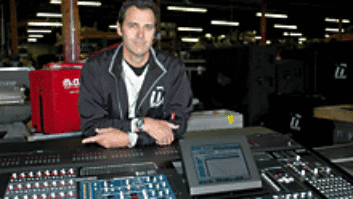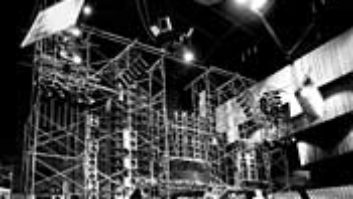On the early days:
“I’m third generation. I started doing local events, bands and things like that and it grew locally. And because the music scene in San Francisco grew around that, my father—my grandfather was more the inventor, the builder—was more the sound engineer, the mixer. He was the first guy to actually tour with a sound system with Herb Albert & The Tijuana Brass Band back in ’66. Before that, nobody traveled with any equipment. And he was doing a show—I think it was Pioneer Days up at Chico State College—in ’66 and Herb Albert & The Tijuana Brass had just come out and they were just becoming a big act and we did a show for him and they came and asked him what it would cost for him to travel with them for a couple of weeks with all the equipment. And nobody had ever done that; nobody had any packaging—all those things. And that started a relationship that went over 15 to 20 years, where he traveled with them all over the world. And from that came the need for bigger and, at the same time, more. Dan Healey, who was working with us and was a big rock ’n’ roll guy, who later went on to work for the Grateful Dead, and he started building the rock ’n’ roll side of what we did with a number of other people.
“Then you had people who were pushing the envelope at all times. People like the Grateful Dead who went through a number of different sound companies and concepts and ideas. A lot of English bands who wanted their shows to be as good as their albums, so they were bringing out studio processing and studio microphones, where that had never been done before. And it’s funny because everybody knows everybody—you ran across somebody because a tour came to town and you saw what they did and you thought, ‘Well, that’s a cool idea to hang it this way or build something like that.'”
On his background:
“Loading trucks. I started off when I was kid when my dad used to take me to shows and I’d tag along with him. I was just happy to load trucks and sweep floors and just watch it all kind of happen. It’s a fun business to be in. I’ve been a sound engineer for most of my life. I’ve worked on the New York Jazz Festival, the San Francisco Jazz Festival, the Monterey Jazz Festival. I did a lot of work in Las Vegas. I did sound for the SuperBowl at Stanford, Calif. I did the sound for the Pope when he was in Monterey, Calif., for a mass for 100,000 people. It all kind of runs together.
“We’ve got offices in San Francisco, Monterey and Anaheim. And we’ve evolved into being a lighting company and a video company and we do everything from the blessing of the animals to the Playboy Jazz Festival at the Hollywood Bowl to Microsoft and Clorox and everything else. There are a lot of companies that specialize in things and it just seems that we’ve always fallen into the ‘do all sorts of stuff.’ It keeps it interesting.”
On the S.F. SR scene:
“San Francisco has probably some of the best production companies anywhere, because—and I think it stems back to the ’60s and ’70s when there was so much music being produced, and plus out of Silicon Valley there’s so much big business—that it’s got so much work and the demand and quality is so high that there is such a variety: boutique companies or larger companies that service all those markets. But it seems we have as much or more high-quality audio/video/lighting companies than anybody else.”
On the digital evolution of consoles:
“The digital evolution of consoles and processing, it’s really making a big difference in the audio side of what we’re doing. It’s almost as if, back in the ’60s and ’70s, guys wanted to do such great things, but the equipment was holding them back. It’s almost like a leap-frogging event that happens with the ability of the operators, engineers and designers to the equipment and then the equipment gets better and then the designers get better—it almost leap-frogs one another to catch up. And we’re right now at a point where the equipment on the audio side is moving so quickly and it can do so much that engineers who have been around for a while being able to wrap themselves around it and be able to translate what they have been doing with how they can move things forward.
“That’s an interesting thing now because there is kind of a dividing line now between two people: People who really want to jump ahead and gamble on the new technology and people who are being conservatists, saying, ‘I don’t want to touch that stuff. I know how to be successful with what I have done before,’ which is analog equipment. We’ve got a number of engineers—all very good engineers—and they’re very polarized with regard to the technology. And it’s interesting to see that because it isn’t always a young versus old or ‘been here for a long time’ and brand new. There are some young guys who are committed to not going to digital. And there are some older engineers who can’t get enough of that stuff and want us to buy more and more of those kinds of things, whether it is system control stuff or consoles or processing.
“It’s moving very fast now and that’s exciting. The other thing that’s interesting about it is you can get incredible product now for what you would think you’d have to pay for like 10 years ago. So the price of, for example, a 48-channel digital console is a lot less than you would imagine it to be and it’s becoming to the point that an analog console of comparable quality with less features costs three and four times more money. So it’s going to be more a financial decision, I think, because digital consoles are cheaper to make. And it’s becoming an art form, too.”







